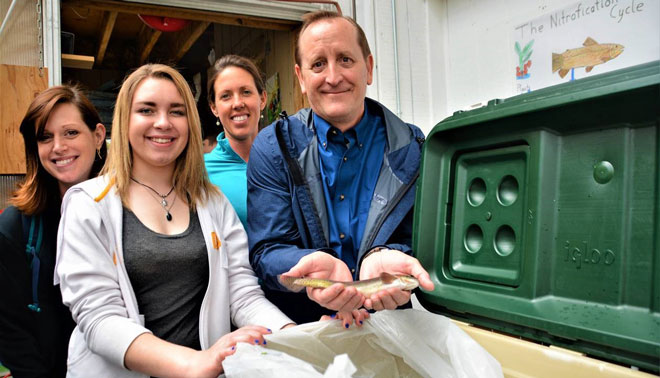Livingston, Montana is a small rural town of about 7,000 people near Bozeman on the outer banks of the Yellowstone River. Most first and second graders in the area attend Winans Elementary School, where nearly half of students receive free or reduced lunch.
At Winans Elementary, healthy snack and celebration guidelines provide guidance for parents to help show the connection between student nutrition and student success, rather than enforcing a policy that restricts unhealthy snacks. Instead of teaching nutritional education to students only, Winans empowers parents with nutritional knowledge on appropriate serving sizes and ideas for healthy, delicious treats with minimally processed foods that have little to no fats or sugars. The program encourages parents to pack healthy snacks that can help keep students focused throughout the school day. By involving parents, healthy eating can become a consistent habit for students that is modeled in multiple settings. Through these programs, the staff at Winans Elementary hopes to promote healthy eating that will serve students throughout the rest of their lives.
In addition to helpful guidance and encouragement, Winans Elementary encourages student nutrition through a partnership with Farm to School Park County (F2SPC). Farm to School of Park County was founded as “Livingston Farm to School” in 2008 and reorganized in 2018 as “Farm to School of Park County” with an eye towards establishing a county-wide presence. This alliance celebrates nutritional consciousness, produce awareness, cooking science, local procurement, and healthy snacking initiatives. When F2SPC applied for the Apples4Ed grant, it’s no surprise that it was well-received by the faculty and staff at Winans Elementary.
F2SPC plays a tremendously important role in the economic and agricultural success of the county and its communities by supporting local farmers, ranchers, and public schools. Their work revolves around three objectives: teach, grow, and eat.
Farm to School Park County staff works alongside Winans Elementary teachers to implement a tactical approach that enables students to experience gardening, harvesting, and cooking vegetation. The F2SPC program staff teaches the faculty at Winans Elementary how to cook and how to harvest Montana vegetation following University of Montana’s Harvest of the Month (HOM)—and coaches them on how to share all of this to students.
Farm to School Program Director Michal DeChellis describes the process: “For example, we’ll grow kale. Then, we’ll harvest it and bring it fresh into the classroom, where students and teachers can make fun, healthy snacks. Then, students will take the recipes home and take it to their parents, so that they can make these snacks together at home. We will also provide students with information about where to find these produce options at local grocery stores and farmers markets.”
Because Montana has a short growing season, the students start growing their vegetation in the springtime, so that when they return from summer break in August, they can continue to grow until mid-October. Farm to School Park County staff teaches the students how to tend the soil in the ten garden beds to achieve a successful harvest season. “The students weed the garden and add in the amendments,” says DeChellis. Some of the crops they grow include garlic, broccoli, peas, kale, squash, corn, bean, tomatoes, and sunflowers.
DeChellis sees the program flourishing into a multifaceted solution: exposing students to delicious produce that they wouldn’t usually pick at the grocery store, and helping teachers store up on snacks to keep students feeling fueled during long school days throughout the year.
“With the program, I think we will be able to add snacks per month on the days that snacks aren’t currently available. We’ll have almost five days of snacks, which is fantastic,” DeChellis shares. The Apples4Ed grant will help fund at least an extra snack a month during the school year.
“Kids get snacks three days a week, through the Fresh Fruit and Vegetable Program, and there are two days a week that they don’t receive snacks. If they don’t get to school on time to get their free breakfast on Mondays, then that is a long stretch of time for them to go until lunchtime,” indicated DeChellis. Thanks to the program, students will be cooking fun, hands-on, colorful, and fuel-packed snacks such as fibrous carrot energy balls and baked kale chips to keep them going until lunch.
Along with the science and mathematics associated with cooking, students will also be practicing their literacy skills as they record their taste reactions to new snacks in food journals. The food journals will then serve as a primary source for an informal longitudinal study, so students can go back and see how their taste preferences evolve overtime after trying various new ingredients.
The Apples4Ed grant will also help fund a cookbook of recipes that students will share at a tasting event for families and community members. The plan is to sell the cookbook to the community to create a direct income source for the “Fill the Snack Pantry” fundraiser.
Reflecting on what the grant means for Park County, DeChellis says, “As a smaller community, we don’t often receive some of these national grants. This was such an amazing surprise.” They hope that with the support of Apples4Ed, students can build confidence around cooking and nutritional choices. The community is also pleased by how this program will not only teach and enrich students by providing an opportunity for parents and children to cook together but by how it will also increase the awareness and support for local producers.








